| |
Major Pathways for Used Oil Disposal and Recycling. Part 2*
Czeslaw Kajdas
Warsaw University of Technology, Institute of Chemistry in Plock and Central Petroleum Laboratory in Warsaw, Poland
Abstract
One of the main concerns with lubricating oil relates to used oil management for both industrial and engine oils, although the environmental impact of gasoline and dicsel engine oils is the most critical. Provided that efficient management systems are in place, most used oil should not reach the environment, so, the major question is 'how should we dispose of collected used oil?' The first option lies in burning it as a fuel, the second in recycling (re-claiming, reprocessing, re-refining). The latter allows recovery of mineral base oils, which are valuable constituents of crude oil.
In the first part of this paper, the author looked at the problems associated with used oil, its use as a fuel, and simple recycling. He went on to look at major re-refining processes, starting with liydrogenation (KTI, Mohawk, BERC/NIPER, and PROP technologies). In Part 2 lie covers other processes, including Safety Kleen, IFP/Snamprogetti, UOP Hylube, and vacuum distillation and clay treatment teclmologies.
Keywords
used oil, disposal, recycling, Safety Kleen, IFP, Snamprogetti, UOP Hylube, vacuum distillation, clay treatment
* Published in: Tribotest journal 7-2, December 2000. (7) 137
INTRODUCTION
Conventional acid/clay technologies are insufficient in relation to today's oils, and modern re-refining to produce clean, high-quality base oils now involves processes such as pretreatment, vacuum distillation, solvent extraction, and hydrogenation. Various hydrogenation processes, including KTI, Mohawk, BERC/NIPER, and PROP, were covered in Part 1 of this paper; in this part, vacuum distillation and clay treatment technologies, some other processes, and environmental policy are examined.
MAJOR RE-REFINING: Hydrogenation - Safety Kleen
The Safety Kleen process can be seen in Figure 1, based on a flow chart of the plant at East Chicago, Indiana, USA,1 one of the largest waste oil re-refineries in the world, which combines wiped-film vacuum distillation and fixed-bed catalytic hydrotreatment2. It has a capacity of about 250,000 t/y. The process begins by removing the water and light solvents using an atmospheric flash drum. The vacuum column/fuel stripper removes most of the fuel and heavier solvents. The vacuum distillation unit performs the combined functions of separating the lubricating oil from the heavy ends and generating multiple product streams. Chemically non-pretreated waste oil tends to foul heated surfaces over time, so thin-film evaporators are used. The lubricating oil cuts are then hydrotreated over fixed beds of nickel-molybdenum catalyst. The hydrotreating is performed in stages to reduce catalyst fouling/poisoning and to enhance final product quality. This step improves thermal stability, colour, and odour, while reducing polynuclear aromatics and removing higher-boiling halogenates and polar compounds. The last steps include a kerosene stripper and base oil dryer.
The aqueous by-product from the atmospheric distillation unit is sent for water treatment, while low-boiling hydrocarbon contaminants (light ends) recovered from all steps are combined for use as a fuel within the re-refinery. As this fuel has a relatively high chlorine content, the boiler system has to be adequately designed. Another by-product, the vacuum distillation residue, is sold as an asphalt extender or as fuel for industrial furnaces fitted with emission controls. The spent catalyst from the hydrotreating step can be regenerated.
The Safety Kleen Corporation has produced a 10W/30 SG/CG engine oil blend using only re-refined base oils, that qualified under MIL-L-46152. All engine tests were passed on the first attempt, and the engine sequence test was augmented by a special requirement for the demonstration of base stock consistency applicable only to recycled oils. Taken over a year of production, no more variability was observed than in similar virgin base oil cuts from two major refineries. The Corporation's own tests of heavy-duty diesel engine vehicles show no abnormal deposits or wear.
The base oils recovered by the Safety Kleen re-refining process meet API standards for base oils. Lubricants made from Safety Kleen base stock include engine oils, gear lubricants, power transmission fluids, hydraulic oils, and industrial oils, all of which meet industry standards and specifications, and do not jeopardise warranties or the performance of equipment. Safety Kleen and its licensees have, worldwide, 262 branches, 13 solvent recycling centres, 3 fuel blending facilities, and 2 used oil re-refining plants.
In general, the technology does not generate unusable by-products.
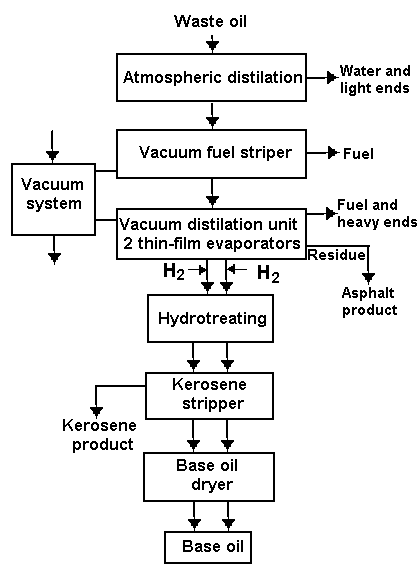 |
Figure 1 Safety Kleen technology
|
Hydrogenation - IFP/Snamprogetti technology
Another vacuum distillation/hydrogenation technology involves propane extraction of heavy ends. The principle of this processing step, developed by the Institut Francais du Petrole (IFP), also known as the Selectopropane Process, is the use of propane to extract selectively all base oil components from waste oil.3 The propane extraction step is similar to that commonly used in crude oil refining to separate asphaltenes for the preparation of heavy neutral base oil (bright stock).
In this process, water-free waste oil from atmospheric distillation is put in an extraction column with liquid propane at 75-95°C. Dirt and insoluble sludge settle out. After extraction, the oil-containing propane is removed from the extractor, while dark-coloured asphaltic components, oxidised hydrocarbons, and suspended solids, are recovered as bottom residue. The propane is removed from the oil-propane mixture, and the oil subjected to further treatment. Extraction of all the base oil components in this technology allows recovery of bright stock from the waste oil feed. Several plants based on this process have been constructed in Europe, for example, Viscolube Italiana, which has used this process for over 20 years in a plant with a capacity of 40,000 t/y of waste oil where the propane deasphalting step is followed by vacuum distillation and clay treatment.
Snamprogetti (Italy) has further developed the IFP process by including a propane extraction step before and after vacuum distillation, and by adding a hydrofinishing step which changes the technology to a four-stage process, without clay treatment4.
Continuing development by IFP has resulted in a set of licensable advanced processing schemes. One of these combines vacuum distillation, propane deasphalting and hydrofinishing. The IFP vacuum/distillation and propane/deasphalting plus hydrogenation technology includes:
- atmospheric distillation to remove water and light ends;
- vacuum distillation to recover light and medium base oil cuts;
- hydrofinishing of the vacuum distillates to produce finished base oils;
- propane deasphalting of the vacuum residue to recover the bright stock fraction; and
- hydrogenation of the brightstock fraction.
The hydrogenation reactor for bright stock includes two catalytic beds. The first one ensures demetallisation, and the second hydrofinishing of the bright stock.
In the first stage of the Snamprogetti technology, the light hydrocarbons and water are removed by atmospheric distillation. In the second stage, all the impurities picked up by the engine oil, including the additives and partly degraded polymers, are removed by extraction with propane. In the next stage, the extracted oil is fractionated by vacuum distillation. The vacuum residue is then submitted to a second extraction stage in which metal content and resinous/asphaltic components are further reduced. The base oil cuts from the vacuum residue (bright stock) are finally hydrogenated to improve the colour and to increase the oxidation stability of the base oils. One plant using this process has been in operation (Figure 2).
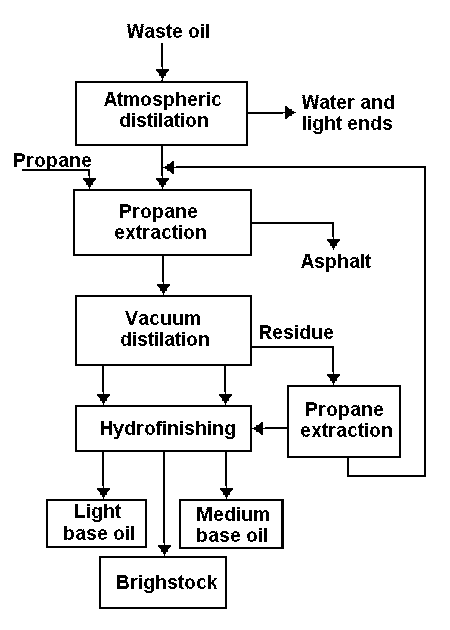 |
Figure 2 Snamprogetti technology
|
Hydrogenation - UOP DCH technology (UOP Hylube process)
This innovative re-refining technology has evolved from existing commercial petroleum refinery technology, and involves treating the entire waste oil in a heated hydrogen-rich atmosphere, whereby the yield of recyclable high-quality products is increased by up to 30%, while at the same time eliminating the coproduction of hazardous distillate fractions. The additional yield makes for an economic process that is competitive with the production of virgin lubricating oil products5.
The UOP technology, known as 'direct contact hydrogenation' (DCH) - the Hylube process - is based on direct contact of the waste oil with heated
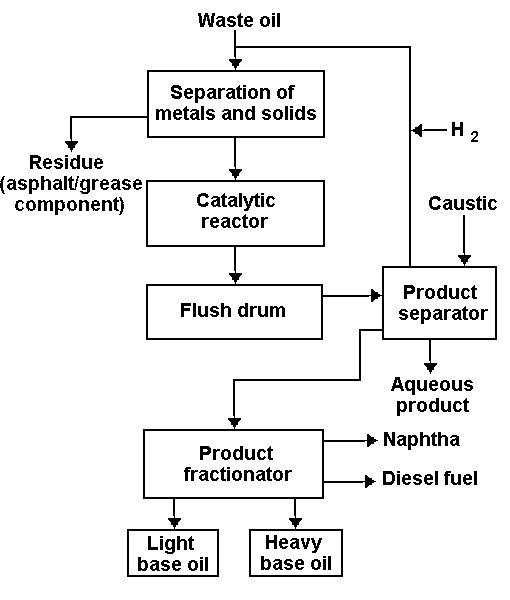 |
Figure 3 UOP direct hydrogen contact technology
|
hydrogen gas. Accordingly, the entire waste oil is treated in a reducing environment that inhibits the formation of polymeric and carbonaceous by-products that cause equipment fouling. Halogenated and oxygenated compounds are destroyed in such treatment, and high-quality, re-usable lighter distillate hydrocarbons are produced, along with purified base oils. A proprietary separation step removes solid and metal contaminants from the waste stream.
Figure 3 illustrates this technology. The waste oil is mixed with hot hydrogen gas, and then injected into a recirculating heated hydrogen gas stream directly upstream of a metal/solid separator. The hydrocarbon mixture, along with the aqueous contamination, leaves the separator with the heated hydrogen gas, and goes directly to a fixed bed catalytic reactor. The flash drum separates the base oil product from the lighter components prior to condensing the aqueous phase, thus keeping the base oil product dry. The flash drum overhead is a mixture of hydrogen gas, light hydrocarbons, water vapour, and the acid gases produced in the catalytic reactor, namely, hydrogen sulphide and hydrogen chloride. Neutralisation and condensation of this highly corrosive stream is accomplished by injecting a caustic solution upstream of a proprietary threephase product separator. The hydrogen-rich gas is recycled. Light oil is recovered and fractionated to produce naphtha range products and diesel fuel. The base oil product is stabilised to remove light gases before directing the material to a product fractionator, where light and heavy base oils are produced. Fuel gas recovery and water treatment are provided to meet environmental emissions requirements. The toxic organic contaminants in the used oil feed are catalytically converted, so that all of the hydrocarbon products from the unit have value. The aqueous stream leaving the Hylube process is further catalytically treated to convert the toxic sulphide compounds to non-toxic sulphates6; the overall result is the processing of the entire oil stream to produce valuable products without the generation of environmentally undesirable by-products. The catalytic hydrotreatment step provides nearly complete conversion of the organic chloride contamination and more than 98% desulphurisation. The heavy residue product in the pilot-plant study can be characterised as an asphalt-blending component. The Hylube process has been tested in pilot plant and is being commercialised. The estimated erected cost for a 60,000 t/y Hylube unit (excluding product fractionation and biological treatment) is $10 million. Product quality and operating costs per ton of lubricant oil produced are competitive with a modern facility producing virgin lubestock.
There are three possible ways in which the Hylube process can be integrated into an existing petroleum refinery:
- lubricant oil refinery,
- fluid catalytic refinery (FCC), and
- refinery with FCC and hydrocracking.
Case studies on such integration show that, in a small lubricant oil refinery, with an increase in total refinery capacity by 10% (10% used oil is admitted as feed), the production of lubricating oils increases by about 33%). Large conversion refineries cannot directly benefit from waste oil integration as much as a small lubricant oil refinery. However, in large conversion refineries, the impact on product quality is minimal. As the Hylube process produces an oil with low coking tendency, the oil is not expected to shorten the catalyst life of the FCC or the hydrocracking unit. In fact, the high hydrogen content of the re-refined oil results in significantly lower coke yield in the FCC relative to virgin feed. (In all three cases, it is assumed that the refinery produces an acceptable quality of asphalt incorporating the Hylube process residue into the product.)
Vacuum distillation and clay treatment - Viscolube
The Viscolube technology, also known as thermal deasphalting (TDA)7, is an improvement of a deasphalting process which has been operated for over 15 years by Viscolube Italiana SpA as a 40,000 t/y capacity plant, using propane deasphalting, followed by vacuum distillation and clay finishing. The TDA process is for a medium size plant, for example, the plant at Pieve Fissiraga (Milan) at 80,000 tons of waste oil a year, supposedly the second biggest re-refinery in Europe.
The process begins by removing water and light ends in a preflash column. Small amounts of additive are injected into the feed. The construction of the facility, and use of additives, reduce dirt and corrosion to a minimum. The dehydrated waste oil is routed to an intermediate storage tank, and the water vapour and light ends are directed to a set of ejectors and then to a separator. The condensed water, after treatment, is further used as process water. The light hydrocarbon fraction is pumped to a storage tank.
The preflashed waste oil from the intermediate storage tank is routed to a pipe still and then to a vacuum distillation (TDA) unit. The proprietary TDA unit has a very high fractionating efficiency, which concentrates organometallic compounds and asphaltic materials in the bottoms. The column operates at a vacuum of ≈20 mmHg and produces three base oil fractions. The bottom is a kind of bitumen material with specific elastic and soundproofing properties, a commercial product suitable for road building and construction. The gas oil produced is sold as a fuel.
The finishing step for the three base oil fractions can be performed using the thermal clay treatment (TCT), followed by press filtration. However, the TDA process can be combined easily with hydrofinishing because of the high purity of the vacuum cuts, giving optimum conditions for using the catalyst. The TDA/TCT process yields 72% re-refined base oil fractions. For the clay finishing step the clay proportion is 7.5%. The clay retains approximately 50% of the oil product, so the spent clay amounts to 10.7% of the waste oil feed. The hydrofinishing step can increase the base oil yield to 75%. The spent clay is easily disposed of as a fuel/raw material for cement kilns. The only process waste is slightly greasy water which represents 4% of the feed, and can be disposed of easily using a simple biological treatment.
The TDA facility in Pieve Fissiraga was completed in March 1992, and is entirely automated, controlled by a distributed control system that maintains detailed feedback between input and output. The process can be run in a single-shift operation with a team of 2-3 operators. Three more re-refineries have come into operation since.
This technology has been improved in cooperation with the Institut Francais du Petrole (IFF). IFP/Viscolube technology provides high yields of rerefined base oils at qualities comparable with virgin base oils. Facilities can be added stepwise relating capital expenditure to local market conditions, desired processing capacity and government incentives. The IFP/Viscolube process for waste oil re-refining is known as Revivoil.
Vacuum distillation and clay treatment - Resource technology re-refining
In this technology, the used oil is dewatered, heated, and then flashed in an atmospheric distillation column to remove remaining emulsified water and fuel fractions. The dehydrated oil is then heated and transferred to a vacuum flash column where more light medium fuel fraction is vaporised. These fractions can be either burnt on site, or sold after some form of finishing, such as clay polishing. The column operates at 100 mmHg, and a spindle oil fraction can also be vaporised. After clay polishing, this fraction is sold as a WON base blending oil.
The remaining used oil is transferred to a cyclonic vacuum distillation tower. This column, operating at 20 mmHg, has a design that obviates the need for conventional internals, such as trays or packing. The oil is injected at high velocity into the column, which generates an extremely large centrifugal force that helps separate the remaining additives and contaminants from the used oil while minimising the formation of coke. In this column, more than 80% of the feed stream is vaporised and sent overhead. The distilled lubricating oil, which is a 220N base blending oil, is condensed, collected and sent for clay polishing. It is mixed with diatomaceous earth and activated clay, followed by filtration in a plate-and-frame filter press.
The oily clay filter cake generated may be disposed of in conventional landfill. The bottoms from the tower consist of the spent additive package and contaminants. This material is marketable, without further processing, to the asphalt industry. The process generates negligible air emissions, and the waste water produced requires minimal treatment.
It is also possible to retrofit the technology to an existing plant by the addition of a cyclonic vacuum distillation column to replace the acid treatment phase in an acid/clay process. It is claimed that such a retrofit can result in a considerable net process saving and at the same time eliminate the problem of hazardous waste. Skid-mounted units of this technology are also available.
Vacuum distillation and clay treatment - Interline
This re-refining technology is based on vacuum distillation/clay polishing. The typical chemical pretreatment stage is, however, replaced by a new, unconventional propane extraction stage8. This new approach blends propane and oil in the first phase of this process, and the extraction is carried out at ambient temperature. The extraction process removes the majority of engine oil additives, with the exception of the viscosity index improvers dissolved in the propane. Propane extraction of the entire used oil stream results in a number of significant technical/economic advantages over traditional re-refining technologies that do not include a hydrogen treatment stage. Most importantly, it allows economic re-refining at volumes much lower than existing non-acid treatment technology. The Interline technology eliminates the need for wiped-film distillation because the extraction phase removes most of the used oil impurities that cause problems in traditional distillation columns. In this case, the purified used oil does not form coke even in a traditional vacuum distillation column. As the process also eliminates the need for a hydrogen finishing stage, it cannot handle waste oil contaminated with PCBs.
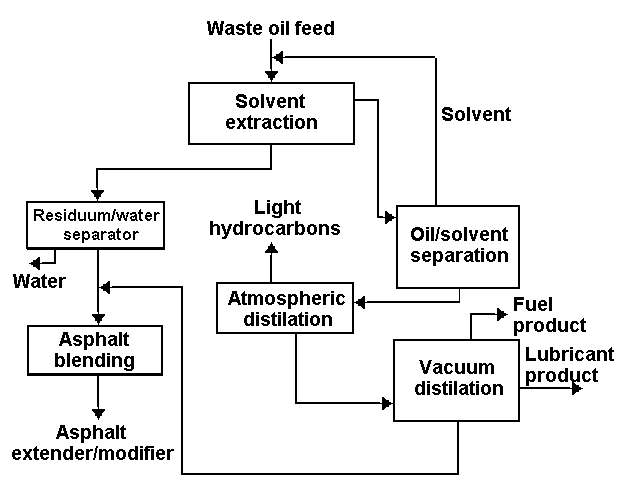 |
Figure 4 Interline technology
|
Figure 4 depicts a simplified Interline process. The raw used oil feed is mixed with propane and the mixture is then sent to a specific solvent extractor, a proprietary system. Most of the additives, water and other insolubles are separated from the propane/base oil mixture. The solids and water settle to the bottom and enter the residuum/water separator where water is separated from a tar-like material which goes to the asphalt blending tank. In this tank, the tarlike material is blended with the vacuum distillation residue to produce an asphalt extender/modifier product. The water is purified and returned to the environment. The solvent/oil mixture is pumped to an oil/solvent separation system. The propane is vaporised at a pressure high enough to allow the propane to be re-condensed at the cooling water temperatures. The regenerated propane is then returned to the solvent extractor to be re-used with incoming used oil. The depropanated oil is set to a light hydrocarbon stripper where the last propane and low-boiling hydrocarbons (gasoline) are removed. The flash adjusted oil is then directed to a traditional vacuum distillation column, which has a mechanical vacuum pump, so that waste water generation is at the lowest possible level. The distilled lubricant oil product is a high-quality base oil which, with a clay polishing step, can be blended and marketed as a virgin quality lubricating stock. The asphalt modifier enhances the temperature characteristics of the final asphalt product.
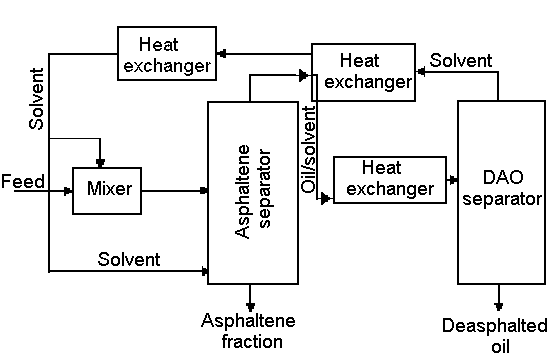 |
Figure 5 Two-stage ROSE unit separator system
|
This technology, although new, has been widely used. A 27,000 t/y plant has been constructed in Salt Lake City, USA, and another 27,000 t/y re-refinery was opened at Stoke-on-Trent, England, in 1996.
Vacuum distillation and clay treatment - ROSE/Kellog
Another re-refining approach has been successfully demonstrated as an option in recycling used lubricants9. It has proved possible to recover oil from grease, which usually contains -85% oil. This technology is based on the Kerr-McGee
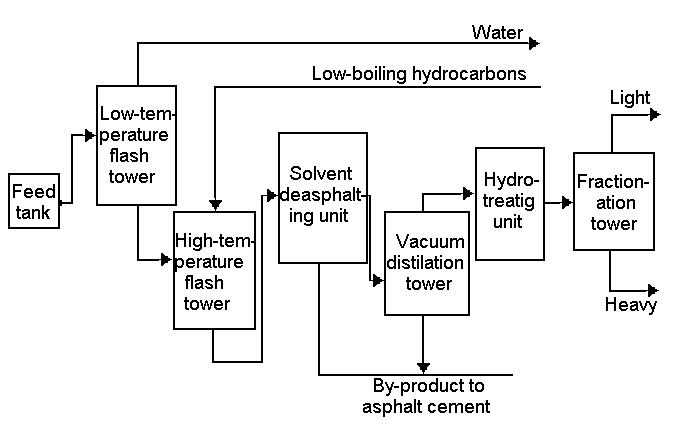 |
Figure 6 ROSE re-refining scheme
|
residuum oil supercritical extraction (ROSE) process, which was sold to the Kellog Company in Houston, TX, USA. The ROSE process is a solvent deasphalting method using supercritical solvent recovery. This provides substantial energy and capital cost savings over conventional solvent recovery techniques. The ROSE technology uses two separation vessels (Figure 5) - an asphaltene separator and a deasphalted oil (DAO) separator. For this application, the feed to the unit is mixed with propane solvent, and charged to the asphaltene separator at a temperature and pressure that cause a phase separation to occur in the vessel. The asphaltene fraction, being the heaviest phase, is withdrawn from the bottom of the vessel, and the lighter fraction, a solution of solvent and cleaner oil, goes overhead. This solution is further heated and flows into the DAO separator at a supercritical temperature and pressure. As Figure 5 shows, another phase separation occurs at this temperature and pressure. The deasphalted oil, being the heavier fraction, is removed from the separator, while the solvent, which is lighter and in a supercritical state, goes overhead. The solvent is then cooled and pumped back so that it can be recycled and mixed with new feed material.
It has been experimentally demonstrated that grease can be blended with used engine oil for re-refining in amounts equal to at least 5 mass%. Figure 6 depicts the solvent deasphalting process followed by vacuum distillation, producing a light vacuum distillate used as a refinery feedstock for processing into lubricant oils or fuels. The final step in lubricant base stock preparation of the vacuum fraction would be hydrotreating or hydrofinishing the fraction.
The advantage of using the supercritical solvent recovery process is the reduction in utility costs. By eliminating the need to evaporate most of the extraction solvent (93% of the extraction solvent can be recovered as a supercritical fluid) the ROSE process also reduces the size and complexity of the plant, saving capital costs.
Other vacuum distillation/clay filtration processes
The high-temperature vacuum distillation step is normally plagued by problems of fouling through coking and carry-over of resinous materials. Continual fouling of the distillation column causes substantial downtime and costly clean-ups. Thin-film/wiped-film evaporators have helped to reduce these problems, and the Luwa thin-film evaporator minimises those problems commonly associated with high-temperature vacuum distillation. The time in the Luwa evaporator limits the amount of time the oils is subjected to high temperatures, while the agitation imparted by the rotor reduces hot-spots that could allow degradation and coking. Another widely used technique is the Pflauder wiped-film evaporator.
The Luwa thin-film evaporator is used in fully-automated, continuous mode by Booth Oil Company, Inc., Buffalo, NY, USA. It has also been installed in the biggest European re-refinery, in Dollbergen, Germany. The Pflauder evaporator is used in the waste oil re-refining plants of Independent Oil Refineries, Australia, and Dominion Oil Refining Co., Ltd., New Zealand. The latter is an example of a successful re-refinery that markets a full range of gasoline and diesel oils, speciality and hydraulic oils derived from re-refined base oil. For the past two decades, these oils have been used in the bus fleet of Auckland Regional Council with Daimler-Benz's endorsement.
No major environmental problems are expected with distillation/clay treatment technology. Odour and waste water problems are not believed to be any more serious in this process than in typical acid/clay technology. Using a barometric condenser as the vacuum column can produce a large quantity of contaminated waste water. Water- or air-cooled surface condensers are preferable to barometric condensers, but are more expensive, and their extra cost must be balanced against the decreased cost of waste water treatment10.
OTHER PROCESSES: Entra
The Entra Company developed a new proprietary waste oil re-refining process that is, to some extent, similar to the above distillation/clay treatment approach, being also based on distillation and clay polishing. However, the key difference is that distillation is carried out in a special linear tubular vacuum reactor11, which consists of a single tube in which the waste oil stream in continuously converted into vapour by rapidly increasing temperature, followed by fractional condensation. The evaporation process, together with chemical reactions, related to cracking heteroatom-containing molecules, proceeds in a controlled How through precise zones of the tubular reactor, at relatively high velocities, with retention times of milliseconds, and maintaining the temperature within 0.2°C of the desired level.
Almost all impurities remain in the residue, which can be generated as granulate, containing all the solid waste oil impurities, soot, and metals. Sulphur and chlorine are converted into salts. Complete dechlorination of the used oil, including the removal of all PCBs, can be achieved by treatment with metallic sodium (usually 0.4% sodium) during which all the chlorine is converted into sodium chloride. To improve the colour of the regenerated oil, 1-3% Fuller's earth is applied.
A pilot plant based on this process has operated since September 1988, with a throughput of 400 kg/h. For dewatered waste oils, the yield of re-refined base stock is over 90%, depending on the contamination content. Another plant of 30,000 t/y has been completed in Germany, for both production and research.
Transformer oil recycling
The Degussa Company has used a sodium process for used oil re-refining together with other companies, the aim being to perfect sodium treatment for regeneration of electrical insulating oils contaminated with PCBs. An example is the Enervac PCB Decontamination Unit in Canada; it is patented in both Canada and the United States, and has approval of Environment Canada and the EPA.
Using this process, waste oil with up to 7,000 ppm of PCBs can be processed, to reduce the PCB level to below detectable levels (2 ppm). The regenerated insulating oil has excellent electrical properties, comparable to those of new insulating oil, and meeting the ASTM specification. The process does not produce any emissions, and is cost efficient, cheaper than other disposal means, and using mobile on-site units.
Another example of this process is in France, at Daffos et Baudasse, Cie., Villeurbanne, with a proprietary process that regenerates waste oils containing up to 10,000 ppm PCBs at 1,000 1/h. Dispersed sodium used in the treatment is prepared according to the Degussa licensed process. According to Enervac, Canada, a small amount of molten metallic sodium dispersion is added to dehydrated and degasified insulating oil in a mixing tank. A reaction takes place that converts the PCBs into harmless compounds, common salt, and a few hydrocarbon residues. These are removed from the oil as a sludge by centrifuge. The sludge is non-PCB-containing and can be disposed of as industrial waste.
GENERAL POLICY TOWARDS WASTE OIL RECYCLING
The major environmental problem in burning waste oil lies in controlling metallic and particulate emissions within acceptable limits. The key environmental problem with re-refining is the disposal of process by-products.
The relative importance of these, in terms of energy conservation and economics, will vary according to specific factors in a given country, associated with crude and base oil or finished lubricant importation.
Other factors affecting waste oil policy are as follows:
- Regulatory apparatus associated with environmental protection and waste oil recycling.
- Volume and quality of waste oil generated.
- Waste oil collection system, and collection cost.
- Availability of re-refining units.
- Cost of fuel oil versus lubricating oil base stock.
Use or disposal of waste oil is clearly an extremely complex issue, but a combination of technology and a favourable attitude may do much to encourage waste oil re-refining, because re-refined base oil manufacturing conserves more energy than does burning waste oil as fuel.
Only well developed and well framed waste oil legislation can properly ensure the recycling of this waste. According to API, the regulation of waste oil should:
- carefully weigh environmental needs and social and economic costs.
- recognise the advantages of resource conservation and encourage the utilisation of used oil in an environmentally acceptable manner.
- be uniform and widely applicable, but sufficiently flexible to recognise local problems and opportunities.
- be based on available and demonstrated rather than anticipated technology.
CONCLUSIONS
The profitability of used oil recycling is controlled by three major factors:
- the price of crude oil,
- the status of the regulatory and legal apparatus relating to environmental protection, and
- tax policy on recycled lubricating oils.
- According to IFP data, the manufacture of 1 tonne of mineral base oil by conventional processing of a typical Middle East crude requires 1.4 to 1.6 tonnes of fuel oil equivalent (FOE), i.e., feed consumed plus energy. The same calculation made on the basis of used oil re-refining shows that the production of 1 tonne of base oil requires 1.1 to 1.2 tonnes of FOE, an advantage of between 0.2 and 0.4 tonnes of FOE per tonne.
- Conventional acid/clay re-refining of waste oil is environmentally unfriendly, as is the clay treatment stage in vacuum distillation. Clay treatment can be made acceptable, as in the Revivoil technology, combining the Viscolube TDA process with the IFF hydrogenation process. Another possibility is applying hydrogenation in a refinery.¹²
- No single re-refining process is perfect for every country. Much depends on the throughput and processing flexibility desired. However, it is worthwhile noting that current technology seems to be converging towards a two-step procedure, vacuum distillation of dehydrated waste oil, and subsequent hydrotreating of distilled stocks. Such technologies as Mohawk, Safety Kleen, and Revivoil usually produce high-quality base oils and concentrate the contaminants in the distillation residue, and the capacity of the first two technologies is quite large. Other innovative re-refining technologies, for example, UOP Hylube or Interline, show promise. The wiped thin-film evaporator also has much potential.¹³
- Re-refining can yield mineral base oil as good as the virgin product. It can also benefit a national economy, particularly with regard to foreign exchange savings: if all the used oil now collected in Europe were recycled by rerefining, it could provide over 20% of the total European base oil demand. The alternative, combustion of used oil as burner fuel, can be condemned as destroying a valuable resource, and polluting through wide dispersion of metal oxides and stable organic contaminants. Additionally, pollutants in used oil may also cause scaling of heat-transfer surfaces and fouling of burners and fuel-transfer lines if not properly handled. Correctly done, the use of reclaimed used oil to provide heat might be a valid recycling pathway, although there remain concerns regarding the handling, re-use and disposal of used crankcase lubricating oils.14
- Modern re-refining technologies provide a wide range of possibilities for recovery of valuable base oil in a manner that is both economically and environmentally acceptable.
References
- Brinkman, D.W., 'Large grassroots lube re-refining in operation'. Oil and Gas J., 19 August 1999, pp. 60-3.
- Brinkman, D.W., Whisman, M.L., Weinstein, N.J., and Emmerson, H.R., 'Environmental resource and economic aspects of used oil recycling', DOE/BETC/RT-80/11, April 1981, pp. 31 and 49.
- Audibert, F, 'Huiles usagées, schemas IFF de raffinage', Revue de 1'IFP, 32, 6 (1978) 935-46.
- 'Waste oil re-refining'. Hydrocarbon processing, September, 1980, p. 143.
- Kalnes, T.N., Youtsey, K.J., James, R.B., and Hedden, D.R., 'Recycling waste oils for profit (UOP direct hydrogenation process)', Haz. Waste and Haz. Mat., 6, 1 (1989) 51-66.
- Kalnes, T., et.al., Treatment and recycling of waste lubricants. A petroleum refinery integration study', paper presented at AICHE Summer National Meeting, San Diego, California, 19-22 August 1990.
- Dalla Giovanna, F., The TDA process', paper presented at UNIDO Sponsored Workshop, Karachi, Pakistan 1992.
- Interline Hydrocarbon, Inc., Alpine, Utah, USA, 1996.
- Smallwood, K.W., and Lynch, K.Z., 'Using solvent deasphalting technology in reclaiming oil from used motor oil and grease blends', NGLI Spokesman, 59, 5 (1995) 34-41.
- Metzeler, S.C., and Jarvis, C., 'Effects of waste oil contamination'. Environment Progress, 4, 1 (1985) 61-8.
- Shorn, C., 'Einrohrreaktorverfahrcn zur Aufarbeitung vom Altoel und fluessigen Abfallstoffen', Description of ENTRA Technology, Achern, ENTRA Ingenieur- und Handels GmbH, 1998.
- 'DEA-Kernrafrinat: die hochwertige Alternative des Altoelrecycling', Proc. 3rd Eur. Cong. Re-Refining, Lyon, France, 1996.
- `Recycling Technology', LUWA paper 43.2992.101.
- Hewstone, R.K., 'Health, safety and environmental aspects of the handling, re-use and disposal of used crankcase lubricating oils', 9th !nt. Coll. Tribology, Technische Akademie Esslingen, Germany, 1994, vol. 2, pp. 13.7-1 to 13.7-9.
- Paper based in part on a presentation at the 3rd European Congress on Re-Refining, Lyon, France.
|





